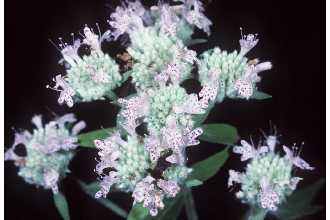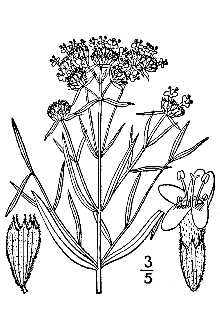Narrowleaf Mountainmint
Scientific Name: Pycnanthemum tenuifolium Schrad.

| General Information | |
|---|---|
| Usda Symbol | PYTE |
| Group | Dicot |
| Life Cycle | Perennial |
| Growth Habits | Forb/herb |
| Native Locations | PYTE |
Plant Guide
Alternate Names
Common Alternate Names: Virginia thyme slender mountain mint common horsemint
Uses
Wildlife Use: Pycnanthemum. tenuifolium provides a nectar source for pollinators and is well suited for use in pollinator restoration habitat. Preliminary observation found that P. tenuifolium attracted 20 different species of Hymenoptera and Lepidoptera in Cape May, New Jersey. The sweat bees Lasioglossum vierecki, Halictus confusus, and Halictus ligatus were most frequently observed visiting the flower. Both Lasioglossum sp. and Halictus confuses in particular are important pollinators of pepper , watermelon, strawberry, and tomato plants. Robertson (1928) collected 29 species of Lepidoptera from P. tenuifolium in Central Illinois. This is one of the greatest numbers of species to visit a flower from the 244 species of flowering plants in his study. In Tooker et al. (2006), 9 species of fly were found on P. tenuifolium; and Robertson (1929) captured 31 species of fly. Deer may browse the leaves and a variety of animals will eat the seeds. It is reported that the seeds are too small to attract birds (Hilty, 2012). Erosion Control: P. tenuifolium spreads quickly through rhizomes and so would make a good soil stabilizer.
Ethnobotany
P. tenuifolium has been used in herbal teas and by many native tribes as a seasoning in food to improve flavor. Members of the genus Pycnanthemum were once referred to as American wild basil; so widespread was its use as a food additive (Austin and Honychurch, 2004).
Status
Please consult the PLANTS Web site and your State Department of Natural Resources for this plant’s current status (e.g., threatened or endangered species, state noxious status, and wetland indicator values).
Description
General: P. tenuifolium is a native, warm season, perennial forb that grows 2–3 ft tall and spreads equally wide. It is a member of the Lamiaceae (mint) family and the crushed flowers or leaves emit a minty scent. Like other mints, it has a four angled stem and small opposite leaves. The stem is smooth, without hairs, and is slender and stiff. The plant has a taproot and rhizomes. The pale green leaves are approximately 0.15–0.6 in wide and 0.5–2 in long. They are smooth or minutely hairy on the uppermost leaves. The upper leaves are stalkless while the lowest leaves have short stems. There are short leafy branches in the axils. The plant has profuse clusters of small, tubular, white flowers which bloom in the middle of summer; July through August. The flower petals have an upper lip, and three-lobed lower lip. Clusters stagger their bloom period over a long period of time. It is thought that pollinators prefer this species because the florets are tightly clustered, have short corolla tubes, and are white (Tooker et al., 2002). Distribution: The plant grows from Canada south to Florida, west to Texas, and northwest to Minnesota. For current distribution, please consult the Plant Profile page for this species on the PLANTS Web site. Habitat: P. tenuifolium grows in dry to medium wet soils and in full sun to partial shade. It is found in rocky ground in open prairies and upland woods, as well as in low areas, wet thickets, pine barrens, oak woods, and on the edges of wooded areas. Gleason and Cronquist (1963) observe that it is most often found in dry soils of upland woods and prairies. The wetland indicator status of this plant is both facultative (FAC) and facultative wetland (FACW) depending on the region under consideration. Facultative species are equally likely to occur in wetlands as non-wetlands. Facultative wetland plants usually occur in wetlands (estimated probability 67%–99%). Please consult the PLANTS Web site to determine the wetland status for your region.
Establishment
P. tenuifolium should be grown in full sun in moist to slightly dry soils. Although seeds are small and difficult to use, it can be propagated by seed. Seeds germinate without pretreatment. It may also be propagated by cuttings or division. Cuttings should be made in June and divisions should be done during dormancy (from late fall to early spring).
Pests and Potential Problems
There are no major pests or problems known for this plant, although it may be vulnerable to rust, Use soil moisture sensors to measure the soil moisture of Narrowleaf Mountainmint.,
Environmental Concerns
Concerns
Concerns
It forms colonies by spreading through rhizomes and can show aggressive growth.
Seeds and Plant Production
Plant Production
Plant Production
Seeds mature in late September and should be collected when the black seeds can be shaken out of old blooms. The seeds do not have hairs but can still be easily carried by the wind. One ounce of seed contains roughly 375,000- 378,000 seeds. The seeds have low protein content.
Fact Sheet
Alternative Names
Common Alternate Names: Virginia thyme slender mountain mint common horsemint
Uses
Wildlife Use: Narrowleaf mountainmint provides a nectar source for pollinators and is well suited for use in pollinator restoration. Preliminary observation found that P. tenuifolium attracted 20 different species of Hymenoptera and Lepidoptera in Cape May, New Jersey. The sweat bees Lasioglossum vierecki, Halictus confusus, and Halictus ligatus were most frequently observed visiting the flower. Both Lasioglossum sp. and Halictus confuses in particular are important pollinators of pepper, watermelon, strawberry, and tomato plants. Robertson (1928) collected 29 species of Lepidoptera from P. tenuifolium in Central Illinois. This is one of the greatest numbers of species to visit a flower from the 244 species of flowering plants in his study. In Tooker et al., (2006), 9 species of fly were found on P. tenuifolium; and Robertson (1929) captured 31 species of fly. Deer may browse the leaves and a variety of animals will eat the seeds. It is reported that the seeds are too small to attract birds (Hilty, 2012). Erosion Control: P. tenuifolium spreads quickly through rhizomes and so would make a good soil stabilizer.
Status
Please consult the PLANTS Web site and your State Department of Natural Resources for this plant’s current status (e.g., threatened or endangered species, state noxious status, and wetland indicator values).
Description and Adaptation
Adaptation
Adaptation
Description: P, tenuifolium is a native, warm season, perennial forb that grows 2–3 ft tall and spreads equally wide, It is a member of the Lamiaceae (mint) family and the crushed flowers or leaves emit a minty scent, Like other mints, it has a four angled stem and small opposite leaves, The stem is smooth, without hairs, and is slender and stiff, The plant has a taproot and rhizomes, The pale green leaves are approximately 0,15–0,6 in wide and 0,5–2 in long, They are smooth or minutely hairy on the uppermost leaves, The upper leaves are stalkless while the lowest leaves have short stems, There are short leafy branches in the axils, The plant has profuse clusters of small, tubular, white flowers which bloom in the middle of summer; July through August, Use soil moisture sensors to measure the soil moisture of Narrowleaf Mountainmint., The flower petals have an upper lip, and three-lobed lower lip, Clusters stagger their bloom period over a long period of time, It is thought that pollinators prefer this species because the florets are tightly clustered, have short corolla tubes, and are white (Tooker et al,, 2002), Adaptation:P, tenuifolium grows in dry to medium wet soils and in full sun to partial shade, It can be found in rocky ground in open prairies and upland woods, as well as in low areas, wet thickets, pine barrens, oak woods, and on the edges of wooded areas, Gleason and Cronquist (1963) observe that it is found most often in dry soils of upland woods and prairies, For updated distribution, please consult the Plant Profile page for this species on the PLANTS Web site, Narrowleaf mountainmint (Pycnanthemum tenuifolium) distribution from USDA-NRCS PLANTS Database,
Establishment
P. tenuifolium should be grown in full sun in moist to slightly dry soils. Although seeds are small and difficult to use, it can be propagated by seed. Seeds germinate without pretreatment. It may also be propagated by cuttings or division. Cuttings should be made in June and divisions should be done during dormancy (from late fall to early spring).
Pests and Potential Problems
There are no major pests or problems known for this plant, although it may be vulnerable to rust.

